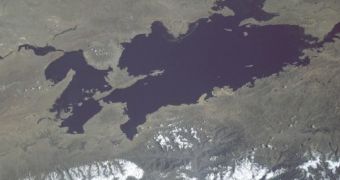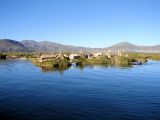Lake Titicaca is located at an altitude of 3,812 m (12,700 ft) in the Altiplano, a high altitude plateau in the central Andes, about 72 km (44 miles) west of La Paz, Bolivia. The lake is located at the border between Peru and Bolivia and its name means "The lake of the puma" in the Aymara language. It has a surface of 8,290 square km (3,300 square mi) and a depth of 370 m (1,230 ft).
This is the largest altitude lake and the highest navigable altitude lake in the world. It is also the largest lake of South America. The lake has a length of 233 km (145 mi) and a maximum width of 97 km (61 mi), being fueled by 25 rivers. Through the Desguadero River, Titicaca is connected to another lake, Poopo, located 300 km (192 mi) to the southwest, at an altitude of 3,686 m (12,270 ft).
Titicaca has 25 islands. Three of them (Isla del Sol "Sun Island", Isla de la Luna "Moon Island" and Suriqui Island) were sacred places for the Incas. The Sun Island has 77 square km (32 square mi) and harbors the Chincana Labyrinth and Pilcocaina Temple. The Palace of the Virgins of the Sun is located on the Moon Island. Local legends say that Pachacamac, the supreme creator, would have gone out from the cold waters of the lake, creating the Sun, the Moon, the Stars and the First people.
Tiwanaku, an important Pre-Columbian civilization, precursor of the Incas, developed near the south-eastern shore of Lake Titicaca, between 200 BC-1,000 AD.
Amongst the inhabitants of the region are the Uros people, who found, in other times, refuge from Inca in the center of the lake. They inhabit artificial islands (called totorals) on the Titicaca Lake.
The islands consist in floating rafts made of totora, a type of reed that grows abundantly at the lake's shore, covered by a thin layers of soil brought from the banks of the lake. These islands can last to 30 years, harboring up to 10 families. Totora is also used for making mats, ceilings, and so on, but also serves as forage.
For traveling around the lake and fishing, the Uros use totora boats (made of bundles of totora reed), with high extremities and made of long totora sheaves, tightly secured with vegetable ropes that make a perfect tightness. They use for driving them poles and even totora sails.

 14 DAY TRIAL //
14 DAY TRIAL // 
